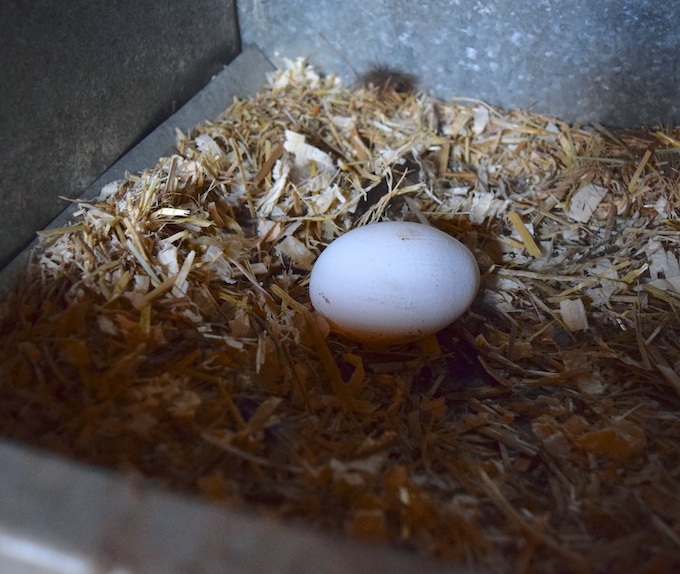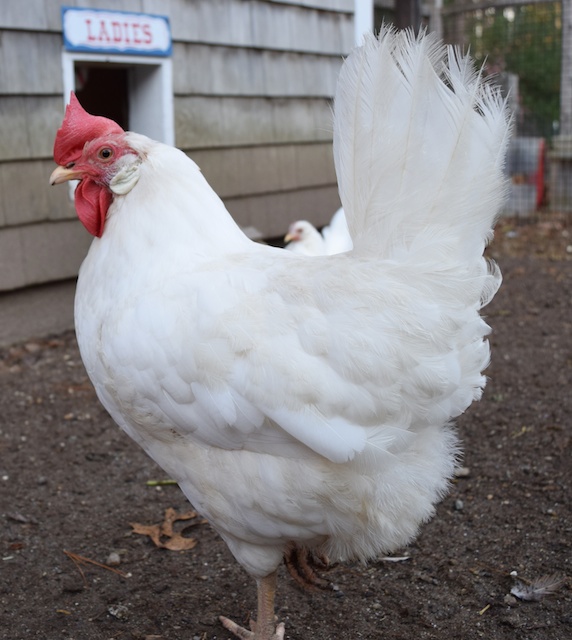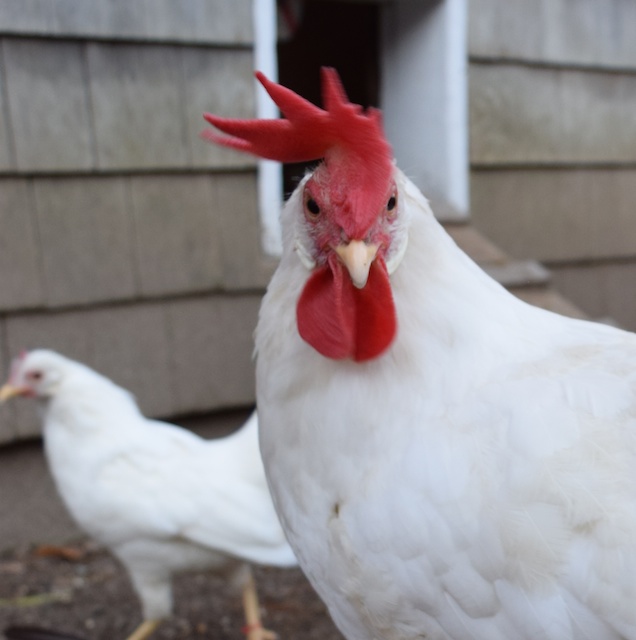Only one of the seventeen hens in my backyard is laying.
Twiggy.
She is a two-year old White Leghorn. Twiggy was the first of a batch of twenty-five chicks (that arrived here in the spring of 2013) to lay. She produced her first egg at the age of 17 weeks. She then laid one egg a day for an astounding two weeks straight before taking a 24 hour break and resuming production. She laid all through last winter, not daily, but enough so that there was always a white egg in the refrigerator.
Twiggy is now 20 months old. All of her flock mates are finishing their molts, which is when a hen drops all 8,000 of her feathers and grows new ones. All birds molt. Chickens molt once a year, the first time that this occurs is at the end of their second summer, at about 18 months of age. Some of my hens molted way back in August and now have perfect plumage, which will keep them insulated and warm through the winter months. Some of the hens are still bare in patches, and their new feathers are just coming in, making them look like porcupine-bird hybrids. Twiggy is the only hen in my flock to not yet even begin to molt. When a hen molts, she ceases to lay. Twiggy is not ready to stop yet. But, look at the tip of Twiggy’s tail. Those are old and worn out feathers. She has got to stop laying. I’ve told her so. She’s not listening.
A hundred years ago, Twiggy’s breed, the White Leghorn, transformed poultry farms. Instead of being marginal animals, cared for out the back door by the farm wife, chickens became the centerpiece of a farm’s business plan. A farm with a large flock of leghorns could turn a profit. This book, published in 1913, is typical of the poultry boosterism at that time.
Instead of laying 90 eggs, like a typical utility chicken of that time, a purebred Leghorn produced more than 200! The evidence from egg laying contests was touted in books, magazines and through government pamphlets.
Over the years I’ve had four bantam White Leghorns. They look like miniature versions of the standard-sized birds. But, like most bantams, they aren’t particularly productive. Twiggy is my first large White Leghorn, and she has more than lived up to her breed’s reputation for being amazingly prolific layers. I keep chickens not only for the eggs, but because I also happen to like hens. Personality is important to me, and I’d heard that Leghorns were “production” birds and not all that interesting. I’ve discovered that that’s not true at all – at least not if you have one Leghorn in a flock of seventeen birds of a variety of breeds. Twiggy is active and a tad flighty, but also personable, and her floppy comb makes her look a tad ridiculous. She’s curious and bold and is a fun foil to the more staid, heavier old-fashioned hens. Leghorns are not long-lived birds, but I’d like to have Twiggy around for a few more years. It’s important for her health that she rests and rejuvenates during the ten-week process that is the molt.
It’s time to molt, Twiggy. Take a break!
She says that she will when she’s ready.






I have 2 standard Leghorns and they are also still going full force in the egg laying production.
Since Twiggy is my favorite, I had noticed she hadn’t molted yet. When I lived on our family farm I had about 50 hens. I had a mixture of Leghorns, Orpingtons, and Austalorps. The White Leghorns were my favorite and are my favorite breed. They are so entertaining to watch. Mine were fairly laid back and weren’t really that flighty. I think having them with some calmer breeds and handling them as chicks into adulthood really helps with their temperament. My uncle had nothing but Leghorns and you couldn’t walk into the hen house without them going nuts. Even tho I had 50 hens I could tell all of them apart. I hope Twiggy gives herself a break soon. She is going to be cold!! My best layers were always the ones who molted last. Just on a side note, the other morning I got on the cam and Veronica was standing right in front of it perfectly. She stood there for a good few minutes. It was amazing to see her so close up. Also sad to see the loss of one of your Big Barn Girls. Speckled Sussex’s are so beautiful. Don’t know much about that breed but they are so pretty. Hope Twiggy gets her much deserved rest soon. Will be intertaining to watch. Just hope she can keep warm!!
I have 4 Araucanas and two of them are still laying. Not every day, but about every other or every third day. They did this last winter – a couple of them laying all winter long after their molt.
I much appreciate their cute little pretty colored eggs in the winter!
Now I finally understand those old cartoons where the chickens lay giant piles of eggs. They were clearly all Leghorns!
I was afraid of this. My kindle can’t handle your new cameras. Now I can’t see the Hen cam or the goatie cam. *sob*
I’ve always had a leghorn or two in my mixed flock. I like them too for the reasons you mentioned. They are the most active of the flock. When heavier breeds reach three or four they really seem to slow down (not just egg laying) but leghorns remain active birds.
I remember as a kid (early 70’s) going to a farm with dad that had over a 1,000 leghorns free range. I remember bringing hens home, why dad did this I don’t remember as we always bought chicks in the sprint.
They had a very large barn for laying and roosting and just ranged about the farm.
This place had a impact on me. It was a true hobby/extra cash farm. They had the hens, a A-frame huts for hogs on pasture, goats for milk, a few beef cattle. It was all well taken care of. The kind of place a child might draw if asked to draw a farm.
The one thing I remember most was the extreme flighty nature of this flock. When we went around back the hens in sight just scattered, running and flying in all directions.
When we opened the door to go into the barn to catch hens you would have thought someone had just let a fox loose in the place. It was complete pandemonium.
Then when we attempted to catch hens it was even worse. Chickens running, flying, squawking, dust, feathers OH MY.
Then one day I was watching animal planet and it was a show on animals defenses. One of the segments was on flamingos. It showed how when the edge of the flock was attacked by a predator and a few birds reacted by flying off that the entire flock responded in this matter as the bird next to them took flight (domino effect). My mind immediately went back to the day of going to get those leghorn hens. I believe that is what was happening. One hen would spook and then the domino effect.
My lovely leghorn named Lavender is laying well too. There is a white egg in the nest box almost every day…I know it’s hers because she is the only white egg layer in my 8 hen flock…we also have 3 Delawares who are also laying, they of course started later than Lavender, they are all 7 months old. What I found interesting is how large her eggs are, she is a small sized bird, but tall, and also very interesting to watch, which is my favorite calming activity….The Delawares are very large and heavy and lay smaller eggs..Lavenders eggs were large right from the start…..I have a picture of my great grandmmother feeding her flock of 50 or so white leghorns. She and my grandmother were great fans of them…there were quite alot of chicken farms here in their day and we can still see many old chicken barns on farms here….In fact my chicken house has windows from the old chicken house that fell down on our family farm…..take care Terry and thanks for all you do…..
No eggs here..I actually BOUGHT some from a friend of mine whose birds are young and not yet molting…I cannot believe I had to shell out money for eggs!
We have about 50 chickens and keep extra light so they will lay all winter.
We also play classical music all day, as we have found the presence of sound keeps predators away, particularly foxes.
Bawk bawk ba gawk!
I think Twiggy is beautiful, and really interesting to watch. Seems she’s almost always on the move, or doing something. Take a break, Twiggy, and soon! It will *not* be fun without your down jacket with the temperatures expected at this time of year.
I have a 4 year-old Harco (Black Star) hen who hasn’t started moulting yet, and she’s still laying almost every day. In fact, she’s one of only two hens that hasn’t stopped laying for the winter, and the other one is a pullet. I’ve been trying to convince her to take a break since September, but so far she’s not listening either.
we had “Red Star” chickens that laid over 300 eggs a year and never molted….but they did die after 2 years.
You know, I’ve never seen a naked chicken in winter. The chickens on the farms I worked usually started molting in August/September. Most were left to free range, so it was feathers feathers everywhere. If she does a large over all molt, do you think you’ll have to bring her in or provide heat for awhile? *shakes head* A naked chicken in winter never occurred to me.
FYI. I sat for awhile on the Goat Cam waiting to see the boys. But the camera was only panning as far as the bucket and back again. And again. And again…
And I finally got to see my first wooly bear caterpillar. It was large and solid black. *sigh*
Sorry about the cams. There was an IT crisis yesterday, which Steve worked tirelessly on. What we do here is very complicated!
I’ll bet. I’m married to a programmer. I confess my eyes glaze over from time to time when he or my son get into the detailed stuff. It’s why I spoke up about the cams. My IT people get very irate if things aren’t reported right away. :D
Robin, we are enjoying very beautiful sunny but very crisp cold fall weather this past week and I have never seen a more naked and pathetic looking chicken as my Golden Campine. She is a sad sight but seems to be tolerating her situation without any signs of distress. She does make me cold though just looking at her. :)
You’re right – even late molters seem to do fine. As long as they have a draft-free coop and a dry place out of the wind, they can manage winter weather.
Always something new to learn! :) For me, however, anything below 80 is too cold. And we’re expecting shoveling snow this weekend. Yuk.
Hope all the naked chickens make it through just fine!
I love Twiggys floppy comb. My easter egger , who I believe is part brwn leghorn, is the only one of mine still laying. She lays every other day very consistently. I always feel bad for the late molters to have to go thru the cold without all their feathers. Enjoy your weekend.
If Twiggy does decide to take a break and molt this year, I’m sure she will do it as quickly as she does everything. One of my Barred Rocks molted in February this year. Sometimes you just can’t talk any sense into them.
I wonder if a white leghorn would stay inside my electric mesh fence with the buff orpingtons and barred rocks? Back before I started fencing out the neighborhood dogs, I had one and loved watching her free range with the local turkeys, but her ability to fly didn’t save her, and I’ve been hesitant to bring in a flyer to my now safer flock. fence is 42 inches high.
Clip her flight wings. That’s what I did to Misty, who flew out of everything. I only had to do it once. Now she doesn’t realize that she can fly!
The Call of the Hen, that is absolutely classic! The dollar sign on the egg just kills me. That’s the funniest book cover I’ve seen in a long time.
I was wondering if high egg production breeds are more likely to have laying problems, like prolapsed vents, or retained eggs?
I was hoping that someone would chime in on that cover. Many city dwellers thought they’d be able to make a living farming chickens. Many went bankrupt.
In my experience the high producers do give out earlier, however, in general, chickens are not long-lived animals and old age is not easy on many of them.
The saying goes, never judge a book by it’s cover. But some book covers are good enough to stand on their own! :^)
(One of my favorites is the USDA Yearbook of Agriculture, “Consumers All” with an illustration of the classic 1950’s nuclear family on the cover!)
Twiggy is amazing, but I well understand that you would like her to have a break and moult. Of my main bantam flock, one only is still laying (started as a pullet in December last year); she is a welsummer cross and, although she’s slowed to laying an egg only every third day, like Twiggy, she shows no decisive sign of moulting. Nice to have some production, though.
Her comb is certainly still nice and bright red; looks like she’s going to keep on laying for a while!
Now there’s a classic calendar pose! That is one of those “Godfather” You lookin’ at me? faces if I ever saw one.